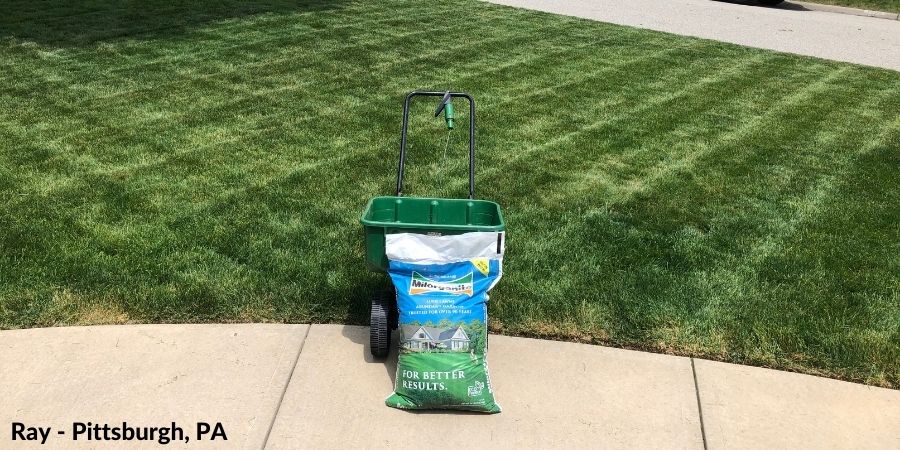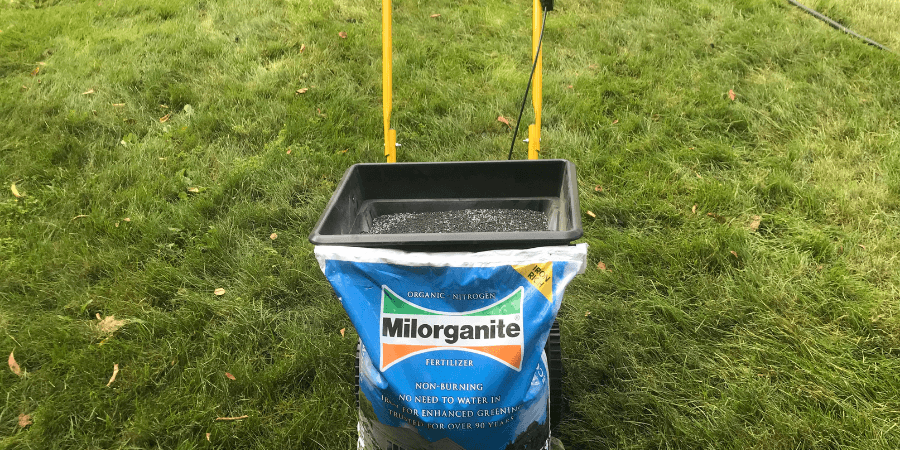What Lawn Spreader to Use and How to Correctly Calibrate it
- Milorganite AgronomistApril 30, 2022
Spreaders are used to evenly distribute fertilizer and grass seed across your lawn. There are two types: drop and broadcast, also known as a rotary spreader. There are two types of broadcast spreaders: walk-behind and hand-held. All spreaders have a hopper to hold the product and an adjustable opening to control the volume of fertilizer or seed being distributed. Are you asking yourself, what kind of fertilizer spreader should I use? Selecting the right spreader for you depends on your lawn and preferences.
What’s a Drop Lawn Spreader?
Drop spreaders are very accurate as they distribute even rows of fertilizer and grass seed exactly where you want it. It’s important that you overlap wheel marks to ensure the entire lawn has been covered. The rate at which you walk directly impacts how much product is distributed.

Why Use a Drop Lawn Spreader?
- Works well for smaller lawns under 5,000 sq. ft.
- Easy to operate.
- Provides precise, controlled coverage.
- Easy to navigate around obstacles and tight spots.
- Product distribution is generally not impacted by the wind.
- Less product will end up on your driveways, walks, and paths.
Drawback:
Drop spreaders cover a smaller area of lawn per pass compared to broadcast spreaders, which means it’ll take a bit more time to fertilize your lawn.
What’s a Broadcast Lawn Spreader?
Broadcast spreaders distribute fertilizer and grass seed in a fan-like pattern in all directions and cover a wider area per pass than drop spreaders. The rate at which you walk and the spreader’s hole size impact how much product is distributed. Broadcast spreaders naturally distribute less fertilizer toward the edge of their broadcast range. Check the spreader manual for tips on how far various types of fertilizers are thrown. Like drop spreaders, make sure to overlap passes so you don’t end up with stripes.

Why Use a Broadcast Lawn Spreader?
- Greater coverage area works well for large lawns.
- Covers more lawn in less time.
- Walk-behind and handheld models are available.
- Hopper capacity of walk-behind models is generally larger than drop spreaders; fewer refills.
- Some broadcast spreaders have a side-shield feature that allows you to shut off half of the spreader, which is particularly helpful for applying product around the perimeter of your lawn and avoiding hard surfaces and landscaping.
Drawback:
The product can be distributed where you don’t want it when using a broadcast spreader, such as in gardens or on driveways, walks, and paths. This is a problem if you’re applying an herbicide, which would be detrimental if it got into your flower bed. This isn’t a concern when using Milorganite, as it can be used on lawns, flowers, shrubs, and vegetables. Make sure to clean up any product from hard surfaces so it doesn’t end up in waterways.
Correct Lawn Spreader Settings
Most homeowners don’t want to calibrate their spreader to discover the correct setting. You just want the setting number, right? Unfortunately, each spreader is slightly different and so are you.
Use spreader settings and application rates as guides. Many variables impact your spreader’s setting to reach optimal application rates, including the type, age, and condition of your spreader, as well as the rate at which you walk. The best way to ensure you’re applying the proper amount of Milorganite is to calibrate your spreader. Below are six easy steps you can follow.
Milorganite is very forgiving compared to synthetic fertilizers or those that contain herbicides. It won’t burn your lawn, so you don’t have to worry much about over-application. Milorganite can be used throughout your yard—on lawns, shrubs, trees, flowers, and vegetables—so you don’t have to worry about accidentally damaging surrounding plants while fertilizing your lawn. This is particularly nice when using a broadcast spreader.
Six (or less) Easy Steps to Calibrate Your Lawn Spreader
We have spreader settings for a number of popular spreaders on our website. If your spreader isn’t listed, it’ll only take a few minutes using six easy steps, to calibrate your spreader.
- Set your spreader so that the opening(s) in the bottom are ¾ open when engaged.
- Put 6.5 pounds or 1/5 of a bag of Milorganite into your spreader.
- Begin fertilizing your lawn, starting along an edge, and continue until the spreader is empty. Leave the spreader where it was when it ran out of Milorganite.
- Measure the area of the lawn you fertilized. You should have covered about 500 sq. ft (20’ x 25’, 10’ x 50’, etc.). If so, skip steps 5 and 6 and continue fertilizing your lawn. If not, go to steps 5 or 6.
- If you covered much more than 500 sq. ft, increase the size of the opening(s) in the bottom of the spreader and repeat steps 2-4 on an unfertilized lawn area.
- If you covered much less than 500 sq. ft, decrease the size of the opening(s) in the bottom of the spreader and repeat steps 2-4 on an unfertilized lawn area.
After you calibrated your spreader for fertilizing with Milorganite, write down the setting, and don’t lose it! You shouldn’t have to calibrate your spreader again

Lawn Fertilizer Application Tips
- Mow your lawn before fertilizing.
- Close the spreader hopper before adding the product.
- Fill the hopper on a drive or walkway to avoid over-application, which is particularly important for herbicides and synthetic fertilizers which can burn your lawn.
- Sweep up any product that falls on hard surfaces to avoid it washing into waterways.
- If you accidentally dump Milorganite on your lawn, gather what you can, then use a stiff broom is spread what remains.
- Walk at a steady pace. You’re an important part of the distribution rate equation. The slower you walk, the more product will be distributed, and less is distributed when you walk faster. That’s one of the reasons application rates can vary.
- Drop spreaders: overlap wheel marks to ensure even coverage and avoid unfertilized stripes.
- First, apply a header strip—two overlapping passes—of fertilizer around the perimeter of your lawn for easier turns.
- Start along the longest edge of your lawn.
- Close the spreader off when making turns to avoid uneven application.
- After a turn, start walking before opening the spreader.
- Apply 50% of the product in one direction and the other 50% in the opposite direction to help ensure even coverage. Do this by reducing your spreader setting by half.
- Avoid spreading the product on windy days so the product stays where you want it.
- Clean your spreader after each use.
- Follow manufacturers’ guidelines for lubricating, cleaning, and storing your spreader.


